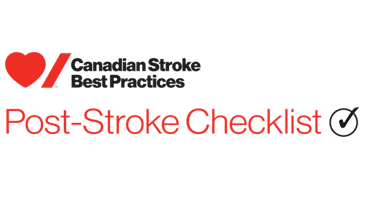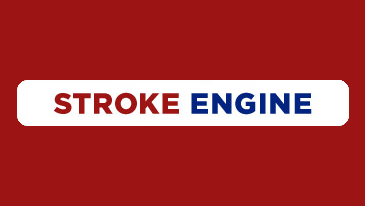- Definition and Considerations
- 1. Supporting People with Stroke, Their Families and Caregivers
- 2. Education for People with Stroke, Their Families and Caregivers
- 3. Interprofessional Care Planning and Communication
- 4. Community Participation Following Stroke
- 5. Transition to Long-Term Care Following a Stroke
- 6. Post Stroke Depression
- 7. Post-Stroke Fatigue
Recommendations
1.0 Persons with stroke, their families and caregivers, should be assessed and prepared for transitions between care stages and settings through information sharing, provision of education, skills training, psychosocial support, awareness of and assistance in accessing community services and resources [Evidence Level B]. Interventions must be person- and family-centered and tailored to their individual values and needs [Evidence Level C].
1.1 Screening and Assessment
- People with stroke, their families and caregivers, should be screened for their level of coping, risk for depression, and other physical and psychological issues [Evidence Level B]. Ideally screening should take place at each transition and additionally when indicated. For additional information, refer to the following CSBPR modules: Mood, Cognition and Fatigue following Stroke; Rehabilitation and Recovery following Stroke; and Acute Stroke Management.
- Validated screening tools or approaches can be used whenever possible to ensure a consistent approach to identifying potential issues during transitions [Evidence Level C]. Refer to Table 1: Tools to Assess Participation and Health-Related Quality of Life.
- People with stroke, their families and caregivers, should undergo in-depth assessment to determine readiness for education and ability to integrate knowledge, training, and psychosocial support, and ability to access appropriate health information and social services [Evidence Level B]. Refer to Section 2 for additional recommendations on education and training.
- Consider assessment of the following issues as they relate to a family member’s or caregiver’s ability to care for the person with stroke:
- Current health status, employment and social responsibilities, and how those will be managed in providing stroke care [Evidence Level B];
- Capabilities and experience in providing care to the person affected by stroke [Evidence Level C];
- Resource issues such as financial situation, housing, transportation, insurance, healthcare benefits, medication cost coverage [Evidence Level C];
- Support from other family members, relatives and social networks [Evidence Level C];
- Ability to cope and manage the added stress of caring for another person following stroke [Evidence Level C].
- The type and depth of assessments should be appropriate to the individual person’s needs, issues identified during screening, and stage of transition [Evidence Level C].
- Consider assessment of the following issues as they relate to a family member’s or caregiver’s ability to care for the person with stroke:
- When issues are identified through screening and assessments, referrals to appropriate experts and services to address issues and optimize outcomes should be made for people with stroke [Evidence Level B], their families and caregivers [Evidence Level C].
1.2 Supporting People with Stroke, Their Families and Caregivers
- Support should be initiated from the onset of stroke and continue throughout all transitions and stages of care. [Evidence Level B].
- The use of telemedicine (e.g., video, and web-based technologies and services such as web-based support groups, tele-rehabilitation), should be considered to increase access to ongoing support services, healthcare services and rehabilitation therapies following transitions to the community; especially in settings where people with stroke and their family members are unable to travel to access care and services [Evidence Level B]. Refer to CSBPR Telestroke Toolkit for additional information
- People with stroke, their families and caregivers should be provided with information about peer support groups in their community where available, descriptions of the services and benefits they offer, and be encouraged to consider participation [Evidence Level C].
This checklist is provided as a guide to help ensure evidence- and consensus- based recommendations are applied to develop a collaborative action plan for each person as they transition to different settings and phases of care.
This checklist is applicable to primary care, the emergency department, acute care, rehabilitation settings, complex care/transitional bed settings, long-term care and community settings. The transitions of care checklist should enable the health care team member to work with the person with stroke and their family to have meaningful dialogues regarding necessary information and services to ensure positive and successful care transitions.
Support for people with stroke, families and caregivers may include:
- Shared decision making/participation regarding transitions across stages of care.
- Accurate and up to date information about the next care setting, what can be expected, and how to prepare.
- Access to restorative care and active rehabilitation to improve and/or maintain function based on the individualized care plan.
- Advance care planning, palliative care and end-of-life care as applicable.
- Counseling, preparation and ongoing assessment for adjustment to change of: living setting; abilities; social roles and relationships;participation, leisure and vocational activities; and, home environment. Also consider impact on family (e.g., spouse or partner, children); potential resource issues (financial), and independence (e.g., driving).
- Written discharge instructions and recommendations should be included in collaborative action plans, and include goals and follow-up care.
- Access to a designated contact person in the hospital or community for continuity of care and questions.
- Access to and advice from health and social service organizations appropriate to needs and stage of transition and recovery.
- Links to and information about local community agencies such as stroke groups, peer visiting programs, meal provider agencies, and other services and agencies.
- Where possible, access to peer supports who have had a stroke and experienced transitions following the acute phase.
- All communications should be available in aphasia-friendly formats as required and appropriate to the health literacy of people with stroke, their families and caregivers.
This recommendation supports the following goals: to emphasize the need for a holistic approach to care; to help people with stroke, families and caregivers to navigate the healthcare system, particularly following the initial acute stage of stroke care; to define the various components of support; to focus on persons with stroke and their families, highlighting the person with stroke and family-centered care approach; and to address needs beyond the physical impact of stroke.
Stroke is a life-altering event that may require an extended recovery period and often leaves persons with stroke with ongoing functional impairments. It also has an impact on others close to the person with stroke, as increasingly, families and caregivers are expected to assume roles, tasks and responsibilities that may be beyond their current skills and knowledge or beyond their physical, financial or time resources. This increases the caregiver burden, which can result in depression among caregivers of persons with stroke (as high as 60 percent has been reported). Similar post-stroke depression rates occur in persons with stroke and are linked to poorer recovery outcomes.
Increased screening, assessment and surveillance of person with stroke, family and caregiver needs and coping will provide a holistic person- and family-centered approach to stroke care and optimally lead to better outcomes and adaptation.
Care transitions take place across the stroke continuum, including primary care, the emergency department, acute care, rehabilitation settings, complex care/transitional bed settings, long-term care and community settings. Processes and mechanisms should be in place in all these settings to address persons with stroke, family and caregiver support using an individual approach, including:
- Protocols to involve persons with stroke and families in healthcare team transition planning meetings and collaborative decision-making regarding goal setting at all transition points.
- Resources and mechanisms to plan and deliver community-based services which consider the needs of the person with stroke and family/caregiver (e.g., home care services, psychological support).
- Models of care that include technology such as telemedicine, regular telephone follow-up and web-based support.
- Appropriately resourced hospitals, rehabilitation facilities, home care services, long-term care and other community facilities that care for persons with stroke, with identified contact people and case managers/system navigators to coordinate manage stroke care transitions.
- Ongoing education and training of healthcare professionals on person- and family-centred stroke care in all settings that care for persons with stroke.
- Opportunities for education and training for persons with stroke, families and caregivers to provide peer support when requested.
- Access to self-management support services through telemedicine technologies, especially in rural areas and where there are local resource gaps.
Clinical and Health System Performance Measures
- The number and proportion of persons with stroke diagnosed with post-stroke depression, measured at each transition point as a proportion of all persons with stroke.
- The number and frequency of persons with stroke readmitted to an emergency department or acute inpatient care for reasons related to physical decline or failure to cope, following an initial stroke hospital stay.
Person-Oriented Measures (PREMS, PROMS)
- The change in burden of care for family members and caregivers measured at transition points throughout the recovery period and following changes in person with stroke health status.
Measurement Notes
- Standardized and validated measures of depression and caregiver burden should be used to track occurrence and changes to these areas.
- Failure to cope diagnosis should be made based on appropriate ICD10 codes.
- Data on readmissions can be accessed through the Canadian Institute for Health Information NACRS ad DAD databases.
Health Care Provider Information
- Taking Action for Optimal Community and Long-Term Stroke Care: A resource for healthcare providers
- Timing it Right (Cameron & Gignac 2008)
- RNAO Best Practice Guideline Care Transitions
- Registered Nurses’ Association of Ontario Guideline: Person and Family-Centred Care
- Transitions between hospital and home (Quality Standards from Health Quality Ontario
Resources for People with Stroke, Families and Caregivers
- Taking charge of your stroke recovery: Rehabilitation and recovery infographic
- Taking charge of your stroke recovery: Transitions and community participation infographic
- Your Stroke Journey: A guide for people living with stroke
- Post-Stroke Checklist
- Heart & Stroke Services and Resources Directory
- A Family Guide to Pediatric Stroke
- Canadian Partnership for Stroke Recovery Patient Resources
- Stroke in Young Adults
- National Stroke Association
- World Stroke Organization Stroke Support Site
- Stroke Engine
- Transitions between hospital and home (Patient Guide from Health Quality Ontario
- Taking charge of your stroke recovery: 2020 Virtual healthcare checklist infographic
Evidence Table and Reference List
Following stroke, patients, families and informal caregivers are typically faced with multiple life changes and challenges as the person with stroke transitions between the stages of recovery. Gallacher et al. (2013) reviewed 69 qualitative studies examining the concept of patient burden following stroke, highlighting the impact it may have on the effectiveness of interventions and patient satisfaction with health care services. The authors identified the components of stroke recovery that were particularly burdensome to patients including receiving information, interacting with others, comparing treatment options, managing in different environments (acute care, inpatient rehabilitation, community, society) and adjusting to daily activities. Caring for a person following a stroke may also have a considerable impact on the health and vocational status of caregivers. Caregivers reported spending significantly longer periods of time providing caring for persons with stroke, relative to pre-stroke levels (Olai et al. 2015). Depression and anxiety may also be increased. Loh et al. (2017) estimated the prevalence of depressive symptoms and anxiety among stroke caregivers to be 40.2% and 21.4%, respectively. Hayes et al. (2009) conducted telephone interviews with 275 veterans who had sustained a first-ever stroke and their informal caregivers to explore the association between caregiver characteristics and the development of injuries. Caregivers who reported a physical injury were more likely to report higher levels of burden, provided more hours of care per week, exhibited more depressive symptoms and fewer healthy days per month compared to carers reporting no injury. The most common type of injury reported was a back injury and 53% of injured carers stated that the injury interfered with their ability to provide care. Significant predictors of injury were higher caregiver burden (OR=1.62, 95% CI 1.14-2.31, p=0.008) and depression (OR=1.10, 95% CI 1.04-1.17, p=0.001). Ko et al. (2007) interviewed 132 caregivers and reported that while 52% were working full time or part-time, prior to the stroke, the majority of working caregivers reported reducing their hours of paid work, or missing work, while 9 caregivers retired or resigned. Rochette et al. (2007) reported that 6 months following stroke, 35.2% of spouses, of a sample of 54 had a high level of burden (Caregiver Strain Index score ≥7) and 17% were identified with possible depression (Beck Depression Inventory BDI score ≥10).
The needs of patients and their informal caregivers has been explored in several qualitative studies using in-person or telephone interviews. Similar themes emerged across studies. Cameron et al. (2014) included 16 patients recruited from an inpatient rehabilitation stroke facility and 15 informal caregivers, who were interviewed following their first weekend pass from inpatient rehabilitation and again 4 weeks following discharge home. Twenty health-care professional (HCP) were also interviewed. Three key themes emerged including issues surrounding preparing patients for safe return home. Patients discussed the need to feel safe in the home environment while caregivers discussed their need to feel supported. Assessing the patient for readiness was a key theme discussed by HCPs. Patients noted gaining insight into what life would be like, and caregivers evaluated their abilities to care for the person with stroke. Patients and caregivers discussed the range of emotions they experienced and how their experienced changes before and after the weekend pass. In a similar study including 24 informal caregivers to persons with stroke and 14 HCP (Cameron et al. 2013), the themes emerged from both the caregivers and the HCP concerned the type and intensity of support needed, who provides support and the method of providing support and the primary focus of care. Creasy et al. (2013) interviewed 17 family caregivers close to the point of discharge from hospital and the again within 4 months of discharge. In the first interview, caregivers expressed information needs related to their role as caregiver in preparation for discharge home and expressed concerns for their own emotional support needs and their ability to provide emotional support. During the second interview caregivers discussed their experiences with caregiver-provider interactions, some of which were positive, others, negative. The caregivers of 90 patients were interviewed one year following stroke (Smith et al 2014). Caregivers reported delays and barriers waiting for applications/funding for alterations to make the home more accessible, having to provide care in the immediate post-discharge period with no skills training and lack of follow-up with GPs. They also described difficulties coping with patients’ quick anger and emotional lability and lack of attention to their physical and emotional ability to provide care.
The feasibility and effectiveness of telestroke has also been evaluated in the context of rehabilitation therapy, where it is often referred to as “telerehabilitation” or “telerehab”. The results of these studies have been ambiguous. Chen et al. (2016) included the results of 7 RCTs that included patients who received rehab therapies through telemedicine systems for a minimum of 4 weeks in duration via virtual reality-based training, telephone, or the internet. There was no additional benefit associated with telerehab, compared to usual care. The mean Barthel Index scores, Berg Balance Scale scores and Fugl-Meyer (Upper Extremity) scores were similar between groups. A Cochrane review (Laver et al. 2013) included the results of 10 RCTs examining telerehabilitation. The number of trials which could be pooled were limited as the treatment contrasts and outcomes assessed were highly variable. Although the authors reported no significant differences between groups in upper-limb function or performance in ADL, they concluded that there was insufficient evidence to support or refute the effectiveness of telerehabilitation following stroke. Chumbler et al. (2012, 2015) evaluated the effectiveness of a Stroke Telerehabilitation program (STeleR) among 52 veterans who had suffered a stroke within the previous two years. The intervention, which focused on improvement of functional mobility, included 3 components: 3x 1 hour televisits to the participant’s home, 5 telephone calls and an in-home messaging device system to instruct patients on functional exercises and adaptive strategies. At 6 months, there were no significant differences in the primary outcomes, the Telephone Version of FIM, the Late-Life Function and Disability Instrument or Falls Efficacy Scale, between groups. There was a significant difference between groups, from baseline to 6 months, in the mean Stroke-specific Patient Satisfaction with Care Scale (hospital care sub score) at 6 months, favouring the STeleR group.





